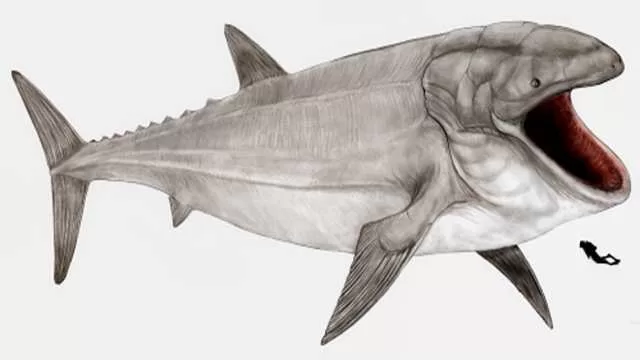Leedsichthys problematicus, a colossal bony fish from the Middle Jurassic period, swam the ancient seas around 165 million years ago. Named after fossil collector Alfred Nicholson Leeds, who discovered its remains near Peterborough, England, Leedsichthys presents a fascinating puzzle due to its fragmented and incomplete fossils. Despite these challenges, scientists have pieced together an intriguing picture of this giant’s life and its place in prehistoric marine ecosystems.
Discovering Leedsichthys: A Fossil Puzzle
Alfred Nicholson Leeds first unearthed the remains of Leedsichthys before 1886. The species epithet “problematicus” aptly reflects the difficulties scientists faced in identifying and interpreting the fragmented fossils. Arthur Smith Woodward, who described Leedsichthys in 1889, initially estimated its length at around 30 feet (9 meters) by comparing its tail to that of another pachycormid, Hypsocormus.
Over the years, more than seventy partial and fragmentary specimens of Leedsichthys have been discovered, complicating size estimates. In 1986, paleontologist David Martill compared Leedsichthys bones to a newly discovered pachycormid, but the unusual proportions led to a wide range of possible sizes. Recent excavations, including the most complete specimen from the Star Pit near Whittlesey, Peterborough, have supported Woodward’s original estimates, suggesting a length between 30 and 33 feet (9 and 10 meters). Isolated elements from other specimens indicate that Leedsichthys could grow up to just over 53 feet (16 meters).
Growth and Gigantism: How Big Could Leedsichthys Get?
Recent studies on the growth ring structures within Leedsichthys bones have shed light on its growth patterns. These analyses suggest that it would have taken 21-25 years for Leedsichthys to reach its full length. This slow and steady growth, coupled with its impressive size, made Leedsichthys one of the largest fish of its time.
Feeding Strategies: A Jurassic Filter Feeder
Much like the modern whale shark and basking shark, Leedsichthys used specialized gill rakers to filter zooplankton from the water. These gill rakers lined its gill basket, allowing it to extract tiny organisms as water passed through its mouth and across its gills. This feeding strategy positioned Leedsichthys as a crucial component of the marine ecosystem, playing a role similar to today’s large filter feeders.
Predators and Survival: The Resilient Giant
Direct evidence of predation on Leedsichthys remains scarce, but one specimen, P.6924, housed in the Natural History Museum of London, tells a compelling story. This specimen shows bite marks from a Liopleurodon-sized pliosaur, a top predator of the Oxford Clay seas. Remarkably, these bite wounds had healed, indicating that Leedsichthys could escape even the most formidable predators of its time, likely thanks to its powerful tail and significant size.
The Legacy of Leedsichthys: A Window into the Jurassic Seas
The discovery and study of Leedsichthys problematicus provide valuable insights into the diversity and complexity of Middle Jurassic marine ecosystems. This giant fish not only showcases the evolutionary adaptations that allowed it to thrive but also highlights the challenges and triumphs of paleontological research.
In summary, Leedsichthys problematicus stands as a testament to the incredible diversity of life that once inhabited our planet’s oceans. Despite the fragmented nature of its fossils, scientists have been able to reconstruct its story, revealing a giant that navigated the Jurassic seas with a unique feeding strategy and the ability to evade even the most fearsome predators. As research continues, Leedsichthys will undoubtedly remain a fascinating subject of study, offering glimpses into a world long past and the evolutionary marvels that once roamed the ancient oceans.

